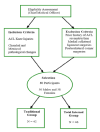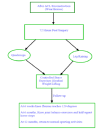The healing effect of the all inside technique is superior to the traditional technique in the reconstruction of the anterior cruciate ligament
- PMID: 38351844
- PMCID: PMC11017173
- DOI: 10.4081/ejtm.2024.11970
The healing effect of the all inside technique is superior to the traditional technique in the reconstruction of the anterior cruciate ligament
Abstract
Our main objective was to examine the curative effect of all inside technique and traditional technique in anterior cruciate ligament (ACL) reconstruction. In our retrospective study at the First People's Hospital of Jiashan County, we analyzed 88 participants with ACL injuries (50 males, 38 females, average age 27 years). They were randomly divided into two groups: traditional ACL reconstruction (42 participants) and all inside ACL reconstruction (46 participants). We measured and recorded the Visual Analog Scores (VAS), International Knee Documentation Committee (IKDC), Lysholm scores, operation time, graft diameter and length between the traditional technique group and all inside technique group. There were statistically significant differences in the Lysholm scores and IKDC scores between traditional and all inside technique groups. The all inside technique showed a higher efficacy and effective post-operative recovery with minimal pain and recurrent injuries. Our findings showed that the differences in gender, age, side of injury and operation time were not significant (p> 0.05). Follow-up was conducted at 6 months and 12 months post operations (mean, 7.5 ± 1.1 months). All inside technique minimizing tissue disruption, optimizing graft placement and facilitating early recovery have a significant impact on patient outcomes.
Conflict of interest statement
We confirm that we have read the Journal’s position on issues involved in ethical publication and affirm that this report is consistent with those guidelines.
According to Marieswaran et al., the ACL is one of the four primary ligaments within the knee joint, situated centrally to provide critical stability. Its primary function is to prevent excessive anterior translation of the tibia relative to the femur and control rotational forces during knee motion. Due to its crucial role in knee joint stability, injuries to the ACL are relatively common, especially in activities involving pivoting, cutting, and sudden direction changes. A diverse array of surgical techniques has evolved over time for ACL reconstruction, each with unique characteristics and goals. The primary objective of these procedures is to replace the injured or torn ACL with a graft, often harvested from the patient's own tissues or procured from a donor source.
Mengaji et al., suggested that traditional ACL reconstruction techniques represent a time-tested and widely adopted approach to addressing ACL injuries. This method involves the creation of tunnels within both the tibia and femur to facilitate the secure placement of the graft. These tunnels serve as anchor points for the graft material, enabling it to mimic the function of the damaged ACL., One of the critical decisions in traditional ACL reconstruction is the choice of graft material. Orthopaedic surgeons typically consider autografts and allografts.,
According to Baawa-Ameyaw et al., autografts involve using the patient's own tissue to reconstruct the ACL. The most commonly utilized autografts are sourced from the patient's patellar tendon or hamstring tendon. The choice between these two depends on various factors, including the surgeon's preference, patient characteristics, and individual knee anatomy. Solie et al., suggested that patellar tendon autografts are renowned for their robustness and ability to restore stability effectively. Hamstring tendon autografts, on the other hand, are valued for their less invasive harvesting technique and potential for reduced postoperative morbidity.
According to Lee et al., allografts employ tissue harvested from cadaveric donors. This approach eliminates the need for harvesting tissue from the patient's body, potentially reducing donor site morbidity. Allografts can be derived from various sources, including Achilles tendon, patellar tendon, or hamstring tendon., While allografts offer advantages related to surgical simplicity and decreased donor site complications, there is a debate about their long-term outcomes compared to autografts.
According to Martinez-Cano et al., the traditional ACL reconstruction procedure typically involves an arthroscopic approach. Small incisions are made around the knee joint, allowing for the insertion of an arthroscope (a small camera) and specialized instruments. The torn ACL remnants are removed, and the tunnels are created in both the tibia and femur using precision drills. The graft is then prepared and positioned in these tunnels. Fixation devices such as screws, interference screws, or suspensory devices are used to secure the graft firmly in place.
The All Inside Technique, as proposed by An et al., represents a modern shift in ACL reconstruction, aiming to minimize tissue disruption while restoring ACL function. Unlike traditional methods with tibial and femoral tunnels, it relies on an internal approach, anchoring the graft within the knee joint itself. This technique starts with arthroscopy and small incisions, preserving healthy tissue and using internal anchoring mechanisms like bioabsorbable implants, sutures, or fixation devices instead of external tunnels.
Aboalata et al., introduced the Anterior Internal Substitution Technique (AIST) as an innovative ACL reconstruction approach, known for favourable patient outcomes and faster recovery. AIST involves arthroscopy, with small incisions for instrument insertion, akin to traditional and all inside techniques. AIST is distinct for its internal graft placement within the knee joint, differing from traditional methods with external tunnels. It secures the graft internally using techniques like sutures, implants, or specialized devices.
Our main objective is to assess the curative effect of all inside technique and traditional technique in anterior cruciate ligament reconstruction.
[Table: see text]
[Table: see text]
Figures





Similar articles
-
Comparative study of the clinical efficacy of all-inside and traditional techniques in anterior cruciate ligament reconstruction.World J Clin Cases. 2023 May 16;11(14):3195-3203. doi: 10.12998/wjcc.v11.i14.3195. World J Clin Cases. 2023. PMID: 37274047 Free PMC article.
-
Superior knee flexor strength at 2 years with all-inside short-graft anterior cruciate ligament reconstruction vs a conventional hamstring technique.Knee Surg Sports Traumatol Arthrosc. 2019 Nov;27(11):3592-3598. doi: 10.1007/s00167-019-05456-9. Epub 2019 Mar 19. Knee Surg Sports Traumatol Arthrosc. 2019. PMID: 30888448 Clinical Trial.
-
[Comparison of femoral oval tunnel technique and round tunnel technique in single-bundle anterior cruciate ligament reconstruction].Zhongguo Xiu Fu Chong Jian Wai Ke Za Zhi. 2020 Mar 15;34(3):323-329. doi: 10.7507/1002-1892.201908030. Zhongguo Xiu Fu Chong Jian Wai Ke Za Zhi. 2020. PMID: 32174077 Free PMC article. Chinese.
-
Early Operative Versus Delayed or Nonoperative Treatment of Anterior Cruciate Ligament Injuries in Pediatric Patients.J Athl Train. 2016 May;51(5):425-7. doi: 10.4085/1062-6050.51.5.11. Epub 2016 May 31. J Athl Train. 2016. PMID: 27244126 Free PMC article. Review.
-
Clinical Outcomes of Arthroscopic Primary Anterior Cruciate Ligament Repair: A Systematic Review from the Scientific Anterior Cruciate Ligament Network International Study Group.Arthroscopy. 2020 Feb;36(2):594-612. doi: 10.1016/j.arthro.2019.09.021. Arthroscopy. 2020. PMID: 32014188
Cited by
-
A Remnant Preservation Technique for All-Inside Anterior Cruciate Ligament Reconstruction.Arthrosc Tech. 2024 Dec 23;14(5):103367. doi: 10.1016/j.eats.2024.103367. eCollection 2025 May. Arthrosc Tech. 2024. PMID: 40548032 Free PMC article.
-
A Simplified Technique for All-Inside Tibial Socket Retrograde Drill Guiding Using a 2- to 3.5-mm Concentric Cannula Without the All-Inside Tibial Guide Ring.Arthrosc Tech. 2024 Aug 23;14(1):103177. doi: 10.1016/j.eats.2024.103177. eCollection 2025 Jan. Arthrosc Tech. 2024. PMID: 39989697 Free PMC article.
-
Finite element analysis of anterior cruciate ligament reconstruction techniques: A comparison of the mechanical properties of all-inside fixation and traditional fixation.Front Bioeng Biotechnol. 2024 Aug 2;12:1438839. doi: 10.3389/fbioe.2024.1438839. eCollection 2024. Front Bioeng Biotechnol. 2024. PMID: 39157441 Free PMC article.
References
-
- Benjaminse A, Webster KE, Kimp A, Meijer M, Gokeler A. Revised Approach to the Role of Fatigue in Anterior Cruciate Ligament Injury Prevention: A Systematic Review with Meta-Analyses. Sports Med. 2019. Apr;49(4):565-586. doi: 10.1007/s40279-019-01052-6. PMID: 30659497; PMCID: PMC6422960. - PMC - PubMed
-
- Fleming JD, Ritzmann R, Centner C. Effect of an Anterior Cruciate Ligament Rupture on Knee Proprioception Within 2 Years After Conservative and Operative Treatment: A Systematic Review with Meta-Analysis. Sports Med. 2022. May;52(5):1091-1102. doi: 10.1007/s40279-021-01600-z. Epub 2021 Dec 2. PMID: 34854058; PMCID: PMC9023382. - PMC - PubMed
-
- An BJ, Wang YT, Zhao Z, Wang MX, Xing GY. Comparative study of the clinical efficacy of all-inside and traditional techniques in anterior cruciate ligament reconstruction. World J Clin Cases. 2023. May 16;11(14):3195-3203. doi: 10.12998/wjcc.v11.i14.3195. PMID: 37274047; PMCID: PMC10237140. - PMC - PubMed
LinkOut - more resources
Full Text Sources

